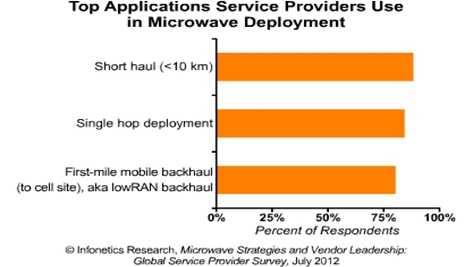英国、ロンドン 2012年8月9日 -マーケットリサーチ会社のInfonetics Research社は同社の最新版マイクロ波戦略とベンダーのリーダーシップサーベイ調査(Microwave Strategies and Vendor Leadership:Global Service Provider Survey)からの抜粋を発表し、その中で事業者の開発計画とマイクロ波機器業者の認識について詳しく調査している。

アナリストノート
「マイクロ波機器市場がますます充実し、現金保守主義的の風潮が続いているので、サービスプロバイダ各社はベンダーとソリューションを違った側面から見つめ、これまでに無いほどしっかりと吟味・評価をしています」とインフォネティクスリサーチのマイクロ波、モバイルオフロード、およびモバイルブロードバンド機器担当アナリストの リチャード・ウェッブ(Richard Webb)は語る。
Webb氏は次のようにも語っている。:「ベンダーにとっては、戦略はどんどんつかみ難いものとなっていますから、平均よりも高い価格で高品位技術へと進むよう取り組まなくてはならなりません。もしくは低価格の(だが低評価の可能性のある)技術に進むか、売られるリスクを冒すかですが、全体的にはっきりしません。それをしっかり理解することは、動いている標的を追うようなものですが、現在、Ericssonは成功しているのです。」
インフォネティクスの2012年5月版 マイクロ波機器(Microwave Equipment) 市場シェアレポートの中で、NECは20%のシェアを占め、2012年の第一四半期で機器収益のトップを獲得した。Ericssonはそのすぐ後に続き、Huaweiが3位に付けた。
マイクロ波調査のハイライト
- Ericssonは、昨年は1項目だけで1位を取って終わっていたが、2012年のマイクロ波調査ではインフォネティクスが揚げた10項目中8項目で、事業会社から最高の評価を得た業者である。
- Huaweiは、インフォネティクスの2011年版マイクロ波調査同様、価格と費用対効果において事業会社から最高の評価を得た。
- イーサネットマイクロ波を導入する事業会社の割合は、現在の19%から2014年までに38%へと大きく成長を続ける。
- 短距離シングルホップ開発およびファーストマイル・モバイルバックホールはマイクロ波展開用として高評価を受けているアプリケーションである。
- 調査に参加した事業会社の3/4以上が、都市部のバックホールモバイル通信用にマイクロ波を使用している。セカンドマイル・バックホールも人気がある。
- 現在から2014年の間に設置されるマイクロ波リンクの1/3は新しいリンクで、主にスモールセルの展開に後押しされている。
For its 38-page Microwave Strategies survey, Infonetics interviewed purchase decision-makers for microwave equipment at 25 independent wireless, incumbent, and competitive operators in EMEA (Europe, Middle East, Africa), Asia Pacific, CALA (Caribbean and Latin America), and North America. The report explores operator plans for deploying microwave equipment and features a vendor scorecard with service provider ratings of 12 microwave manufacturers (Alcatel-Lucent, Aviat Networks, Ceragon, DragonWave, ECI Telecom, Ericsson, Huawei, Intracom, NEC, Nokia Siemens Networks, SIAE, ZTE).
(原文)
Ericsson gets surprisingly high marks from operators in Infonetics microwave survey
London, UK, August 9, 2012-Market research firm Infonetics Research released excerpts from its new Microwave Strategies and Vendor Leadership: Global Service Provider Survey, which explores operators' deployment plans and perceptions of microwave equipment suppliers.
ANALYST NOTE
"As the microwave equipment market gets more and more crowded and the climate of cash conservatism persists, service providers are looking at different aspects of vendors and their solutions with ever-greater scrutiny," says Richard Webb, directing analyst for microwave, mobile offload, and mobile broadband devices at Infonetics Research.
Webb adds: "For vendors, strategy has become an increasingly slippery slope-they have to grapple with going in with strong technology at a higher-than-average price, or with lower-priced (but potentially lower-rated) technology, or running the risk of being solid but indistinct across the board. Getting it right is a moving target that currently Ericsson hits on bullseye."
In Infonetics' May 2012 Microwave Equipment market share report, NEC held the lead in equipment revenue for the first quarter of 2012 with 20%, just ahead of Ericsson; Huawei was 3rd.
MICROWAVE SURVEY HIGHLIGHTS
- Ericsson is the highest-rated vendor by operators in 8 out of 10 of the criteria Infonetics asked about in its 2012 microwave survey, compared to finishing 1st in only 1 criterion last year
- Huawei received high scores from operators in pricing and price-to-performance ratio, as it did in Infonetics' 2011 microwave survey
- The portion of operators deploying all-Ethernet microwave is growing significantly, from 19% now to 38% by 2014
- Short haul, single hop deployment, and 1st-mile mobile backhaul are highly rated applications driving microwave deployments
- Over 3/4 of surveyed operators use microwave for backhauling mobile traffic in urban areas; 2nd-mile backhaul is also popular
- 1/3 of microwave links deployed between now and 2014 will be new links, largely driven by the rollout of small cells

